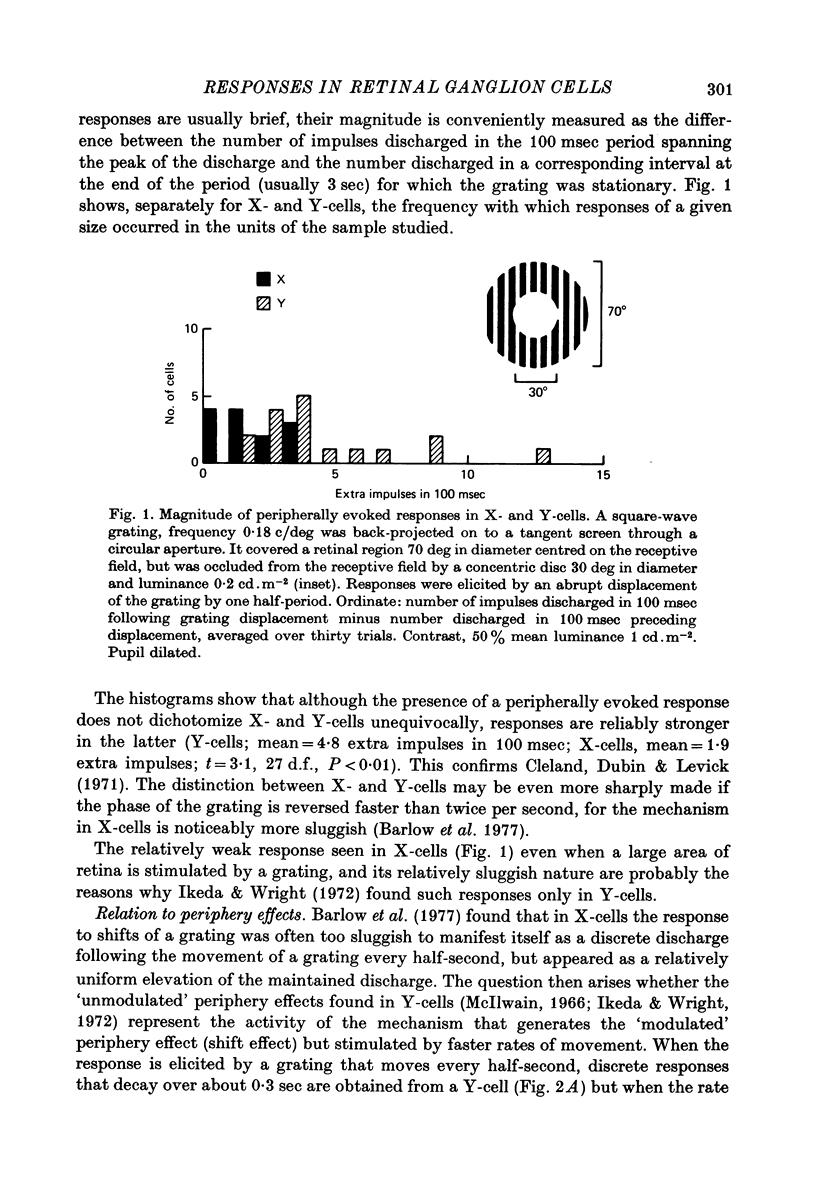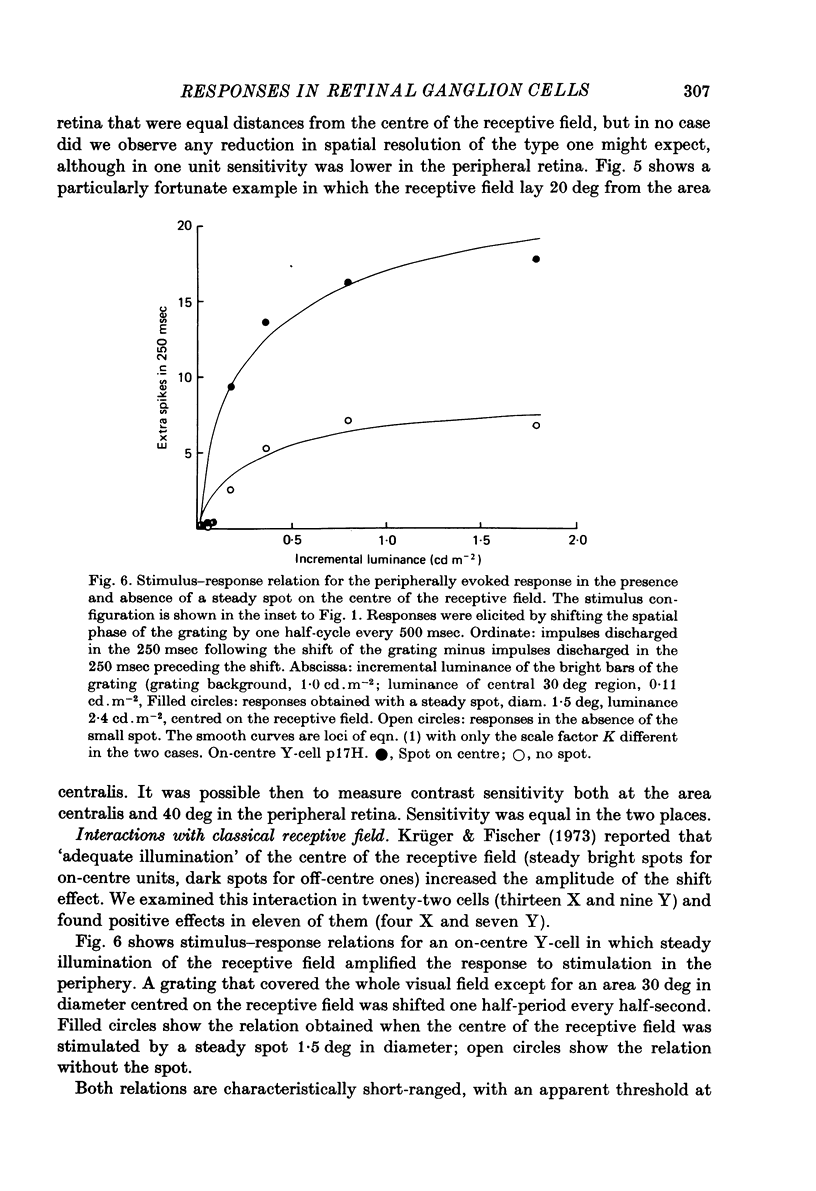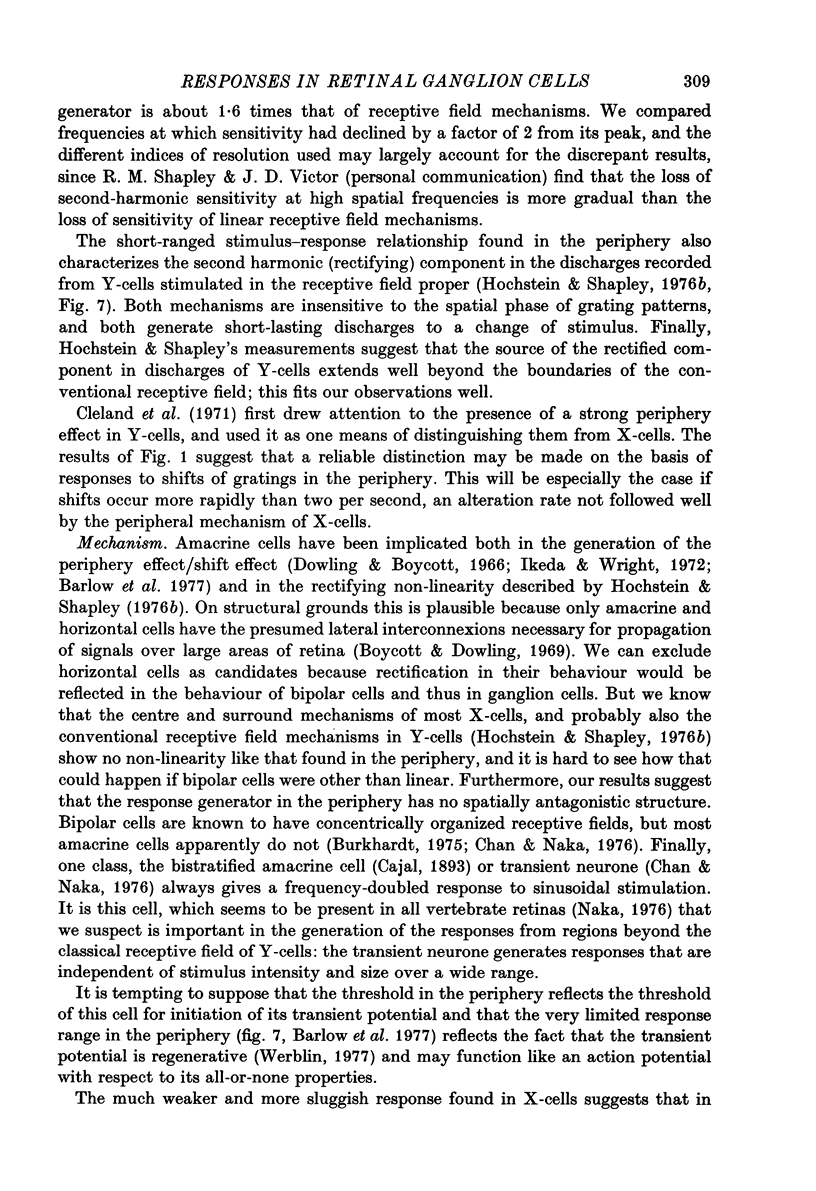Abstract
1. Responses to stimulation of retinal regions remote from the classical receptive field were recorded from optic tract fibres in lightly anaesthetized cats. 2. X- and Y-cells gave reliably different responses to the sudden reversal of the phase of a high contrast grating that fell on the retina more than 15 deg from the centre of the receptive field. 3. The mechanism that generates these responses ('shift effect' or 'periphery effect') in Y-cells is insensitive to the spatial phase of the stimulating grating. It can resolve gratings of higher spatial frequency than can be resolved by the classical receptive field mechanisms of Y-cells but its temporal resolution is poorer. 4. Signals that contribute to peripherally evoked responses are accumulated over a region that extends to at least 35 deg from the centre of the receptive field. Although this region is not uniformly sensitive, regions in the periphery of the visual field are as effective as regions around the area centralis in eliciting the responses, and do not require coarser gratings. 5. In some Y-cells the response to peripheral stimulation was amplified by increasing (on-centre units) or decreasing (off-centre units) the steady illumination of the centre of the receptive field. This confirms Krüger & Fisher (1973), but the effect is only found in a proportion of cells. 6. The mechanism that generates peripherally evoked responses is tentatively identified with the 'rectifying subunits' postulated by Hochstein & Shapley (1976b) to account for the spatial non-linearity in the receptive fields of Y-cells. Transient (bistratified) amacrine cells are known to have many of the properties attributed to these mechanisms (Chan & Naka, 1976).
Full text
PDF











Selected References
These references are in PubMed. This may not be the complete list of references from this article.
- BISHOP P. O., KOZAK W., VAKKUR G. J. Some quantitative aspects of the cat's eye: axis and plane of reference, visual field co-ordinates and optics. J Physiol. 1962 Oct;163:466–502. doi: 10.1113/jphysiol.1962.sp006990. [DOI] [PMC free article] [PubMed] [Google Scholar]
- Barlow H. B., Derrington A. M., Harris L. R., Lennie P. The effects of remote retinal stimulation on the responses of cat retinal ganglion cells. J Physiol. 1977 Jul;269(1):177–194. doi: 10.1113/jphysiol.1977.sp011898. [DOI] [PMC free article] [PubMed] [Google Scholar]
- Burkhardt D. A. A nascent electrophysiology of amacrine cells. Invest Ophthalmol. 1975 Mar;14(3):171–173. [PubMed] [Google Scholar]
- Chan R. Y., Naka K. The amacrine cell. Vision Res. 1976;16(10):1119–1129. doi: 10.1016/0042-6989(76)90252-2. [DOI] [PubMed] [Google Scholar]
- Cleland B. G., Dubin M. W., Levick W. R. Sustained and transient neurones in the cat's retina and lateral geniculate nucleus. J Physiol. 1971 Sep;217(2):473–496. doi: 10.1113/jphysiol.1971.sp009581. [DOI] [PMC free article] [PubMed] [Google Scholar]
- Dowling J. E., Boycott B. B. Organization of the primate retina: electron microscopy. Proc R Soc Lond B Biol Sci. 1966 Nov 15;166(1002):80–111. doi: 10.1098/rspb.1966.0086. [DOI] [PubMed] [Google Scholar]
- Enroth-Cugell C., Robson J. G. The contrast sensitivity of retinal ganglion cells of the cat. J Physiol. 1966 Dec;187(3):517–552. doi: 10.1113/jphysiol.1966.sp008107. [DOI] [PMC free article] [PubMed] [Google Scholar]
- Fischer B., Krüger J., Droll W. Quantitative aspects of the shift-effect in cat retinal ganglion cells. Brain Res. 1975 Jan 17;83(3):391–403. doi: 10.1016/0006-8993(75)90832-x. [DOI] [PubMed] [Google Scholar]
- Hochstein S., Shapley R. M. Linear and nonlinear spatial subunits in Y cat retinal ganglion cells. J Physiol. 1976 Nov;262(2):265–284. doi: 10.1113/jphysiol.1976.sp011595. [DOI] [PMC free article] [PubMed] [Google Scholar]
- Hochstein S., Shapley R. M. Quantitative analysis of retinal ganglion cell classifications. J Physiol. 1976 Nov;262(2):237–264. doi: 10.1113/jphysiol.1976.sp011594. [DOI] [PMC free article] [PubMed] [Google Scholar]
- Ikeda H., Wright M. J. Functional organization of the periphery effect in retinal ganglion cells. Vision Res. 1972 Nov;12(11):1857–1879. doi: 10.1016/0042-6989(72)90076-4. [DOI] [PubMed] [Google Scholar]
- KUFFLER S. W. Discharge patterns and functional organization of mammalian retina. J Neurophysiol. 1953 Jan;16(1):37–68. doi: 10.1152/jn.1953.16.1.37. [DOI] [PubMed] [Google Scholar]
- Krüger J., Fischer B. Strong periphery effect in cat retinal ganglion cells. Excitatory responses in ON- and OFF- center neurones to single grid displacements. Exp Brain Res. 1973 Oct 26;18(3):316–318. doi: 10.1007/BF00234601. [DOI] [PubMed] [Google Scholar]
- LEVICK W. R., OYSTER C. W., DAVIS D. L. EVIDENCE THAT MCILWAIN'S PERIPHERY EFFECT IS NOT A STRAY LIGHT ARTIFACT. J Neurophysiol. 1965 May;28:555–559. doi: 10.1152/jn.1965.28.3.555. [DOI] [PubMed] [Google Scholar]
- MCILWAIN J. T. RECEPTIVE FIELDS OF OPTIC TRACT AXONS AND LATERAL GENICULATE CELLS: PERIPHERAL EXTENT AND BARBITURATE SENSITIVITY. J Neurophysiol. 1964 Nov;27:1154–1173. doi: 10.1152/jn.1964.27.6.1154. [DOI] [PubMed] [Google Scholar]
- McIlwain J. T. Some evidence concerning the physiological basis of the periphery effect in the cat's retina. Exp Brain Res. 1966;1(3):265–271. doi: 10.1007/BF00234346. [DOI] [PubMed] [Google Scholar]
- Werblin F. S. Regenerative amacrine cell depolarization and formation of on-off ganglion cell response. J Physiol. 1977 Jan;264(3):767–785. doi: 10.1113/jphysiol.1977.sp011693. [DOI] [PMC free article] [PubMed] [Google Scholar]


